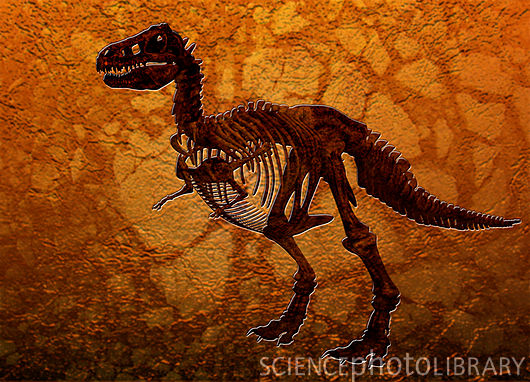看过好莱坞影片《侏罗纪公园》的人,都会对身体庞大、性情凶猛的霸王龙留下深刻印象。而美英两国专家的一项新研究显示,这一恐龙时代统治者的体型比此前估计的还要大。
美国菲尔德自然历史博物馆和英国皇家兽医学院的研究者,日前在美国《科学公共图书馆—综合》网络版上报告说,他们利用激光扫描了5种霸王龙的骨骼,并以此建立三维数字模型,为霸王龙的皮肤、头、颈等身体各部位模拟复原,估算它们的体重。被扫描的骨骼包括保存在菲尔德自然历史博物馆、名为“休”的霸王龙,其骨骼被认为是目前已知最大、最完整的霸王龙骨骼。这项扫描工作并不简单,研究者还请来芝加哥警察局的侦探携带尸检扫描仪助阵。

霸王龙的体型超过预期
模拟结果显示,6700万年前生活在北美大平原的“休”体重超过8.2吨,比此前估计的要重30%,其在发育迅速的青少年时期胃口很大,每年体重可增加近1800公斤,超过此前估计的一倍多。
菲尔德自然历史博物馆的研究人员彼得·马科维奇说:“我们知道霸王龙很大,但比此前估计的体重还多30%令人难以想象。”
研究者指出,霸王龙胃口大意味着它们的领地范围也很大,数量则可能较稀少;青少年时期生长迅速则表明,它们的代谢速度快,有可能是温血动物;其身体很重则会付出灵活性降低等代价。
相关英文论文摘要:
A Computational Analysis of Limb and Body Dimensions in Tyrannosaurus rex with Implications for Locomotion, Ontogeny, and Growth
The large theropod dinosaur Tyrannosaurus rex underwent remarkable changes during its growth from <10 kg hatchlings to >6000 kg adults in <20 years. These changes raise fascinating questions about the morphological transformations involved, peak growth rates, and scaling of limb muscle sizes as well as the body's centre of mass that could have influenced ontogenetic changes of locomotion in T. rex. Here we address these questions using three-dimensionally scanned computer models of four large, well-preserved fossil specimens as well as a putative juvenile individual. Furthermore we quantify the variations of estimated body mass, centre of mass and segment dimensions, to characterize inaccuracies in our reconstructions. These inaccuracies include not only subjectivity but also incomplete preservation and inconsistent articulations of museum skeletons. Although those problems cause ambiguity, we conclude that adult T. rex had body masses around 6000–8000 kg, with the largest known specimen (“Sue”) perhaps ~9500 kg. Our results show that during T. rex ontogeny, the torso became longer and heavier whereas the limbs became proportionately shorter and lighter. Our estimates of peak growth rates are about twice as rapid as previous ones but generally support previous methods, despite biases caused by the usage of scale models and equations that underestimate body masses. We tentatively infer that the hindlimb extensor muscles masses, including the large tail muscle M. caudofemoralis longus, may have decreased in their relative size as the centre of mass shifted craniodorsally during T. rex ontogeny. Such ontogenetic changes would have worsened any relative or absolute decline of maximal locomotor performance. Regardless, T. rex probably had hip and thigh muscles relatively larger than any extant animal's. Overall, the limb “antigravity” muscles may have been as large as or even larger than those of ratite birds, which themselves have the most muscular limbs of any living animal.
英文论文链接:https://www.plosone.org/article/info%3Adoi%2F10.1371%2Fjournal.pone.0026037







